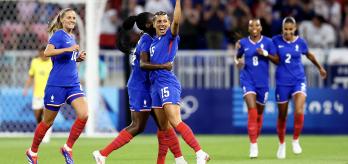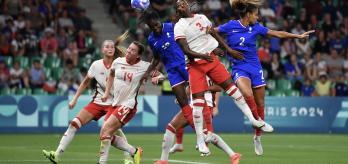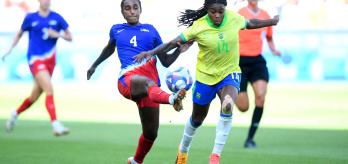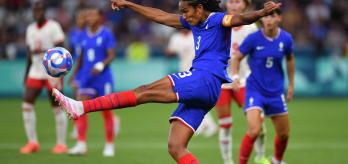One of the key features of the USA’s performances was the understanding that players appeared to have in performing their roles for the team, as Signeul explains.
“Selecting your preferred best players, letting them get playing time together and choosing a way of playing that suits the key strengths of these players is really important at international level. Their team was quite consistent throughout the tournament, so they were able to build relationships and understanding, even though Hayes had not been in charge for very long,” she stated.
In Possession
The USA tended to dominate the ball in their games and were ranked second overall for the percentage of time spent in possession (57.8%) with only Spain ahead of them (63.1%). This is an improvement in possession time from the FIFA Women’s World Cup Australia & New Zealand 2023™, where they averaged 48.4% in possession time in matches. They were patient in their build-up when needed but could switch to fast-paced attacks and counter-attacks and could break the lines of their opposition’s defensive structure.
In clip 1 below, Kirsty Yallop explains some of the key principles of how the USA built their attacks.
“Even though they played with a back four, the USA like to build in a three, often pushing one (or both) of their full-backs really high to help maintain width in their attacking shape, while their forward players looked to position centrally to overload opposition centre-backs. This gave their own players more passing options ahead of the ball to play through the lines. If one central midfielder dropped in to build with the two centre-backs, the other two worked hard to move to receive the ball and to open the pitch to switch play. Players were not afraid to drive forward with the ball while team-mates inside moved into spaces between the opposition lines and offered to receive, while the front three (Sophia Smith, Mallory Swanson and Trinity Rodman), were always available in the vicinity of the penalty area, looking for cut-backs and they were explosive and powerful when driving at defenders and towards goal.”
The attacking roles for both full-backs can be seen in clips 2 and 3 below, highlighting the advanced positions they take and the working relationships they have with the wide forwards.
Line breaks
During this tournament, the USA completed 70% of their attempted line breaks (ranked third behind Brazil and Spain) but crucially, they were the second-most successful team when it came to breaking the opposition’s defensive line, registering 13.8 defensive line breaks per 30 minutes in possession (behind France with 14 P30IP). More importantly, they were the number one ranked team for line breaks through the opposition’s defensive line (as opposed to going over or around it) with 4.7 completed P30IP.
As Signeul explains, “Their biggest asset is their line breaking passes in a long attack as well as in a counter-attack with the skillful movements by their forward players giving great options to receive in behind the opponent’s backline. Once they got in behind, players like Swanson, Smith and Rodman had the pace, power and technique to generate genuine goalscoring opportunities. In addition, across their backline and midfield, they have players with the vision and technique to play these line-breaking passes with accuracy and precision while players ahead of them make line-breaking runs.
“The USA attacked in numbers and even when the attacks were fast and into the space behind the opponents’ defensive line, there was always good support for the player in possession, with additional players getting into the penalty area to finish on cut-backs and crosses,” she explained.
Defensive line break assists
A standout feature of these defensive unit line breaking passes was the fact that four of them proved to be the assist passes prior to crucial goals being scored, including the winning goal in the quarter-final against Japan, the winning goal in the semi-final versus Germany and the winning goal in the final against Brazil.
Only six other goals in the whole tournament were scored directly from defensive line breaks (Brazil 2; Australia 2; Canada 1; Spain 1) so it is clear to see how important this ability was for the USA team.
Three of these goals can be seen in the clips below and as Signeul explains, the combination of the pass accuracy and the quality of finishing was devastating for their opponents.
“Some of these goals were huge moments and made all the difference, at the very highest level, in very tight games against very good teams. It is the decision-making and technical execution of the line breaking passes in these situations that create the opportunities for these fantastic finishes. The speed of play once the defensive line is broken makes it so difficult for opposition defenders to stop.”
In clip 4, we see Rodman’s extra-time winner against Japan. Left-back, Crystal Dunn (7), switches play with an inch-perfect diagonal ball, which breaks Japan’s defensive line. Rodman still has a lot of work to do to beat the defender and create space for the attempt at goal, and she does so brilliantly, scoring a stunning winning goal.
In clip 5 against Germany, we see a fast USA counter-attack in the 89th minute of their second group stage match. Rodman (5) tracks back and regains the ball before driving forward into space. She plays inside to Mallory Swanson (9) who receives between Germany’s midfield and defensive lines, and she drives forward with the ball with two runners ahead of her. She picks out Lynn Williams (8) to her left, breaking her opponent’s defensive line before Williams finishes with a low, left-footed strike into the far-right corner of the goal.
In clip 6 from the Olympic final, Korbin Albert (3) picks up the ball in midfield and plays a quick, straight ball forward, which breaks Brazil’s defensive line and releases Swanson (9). She takes two touches while running at speed before scoring the match-winning goal.
Out Of Possession
One of the most impressive features of the USA’s defending in this tournament was their bravery and commitment in 1v1 situations. Hayes’ side were ranked number one overall for tackles won per 30 minutes out of possession with an average of 17.2 per game. Their aggressive out-of-possession nature is also reflected in the fact they were ranked third (behind Spain and Brazil) for direct pressures applied with 73.2 per 30 minutes out of possession, executing the highest volumes of their direct pressures when in the counter-press (106) and defensive transition (125) phases. In addition, they were the number one ranked team for out-of-possession time spent in recovery phase (7.4% compared to the tournament average of 4.3%).
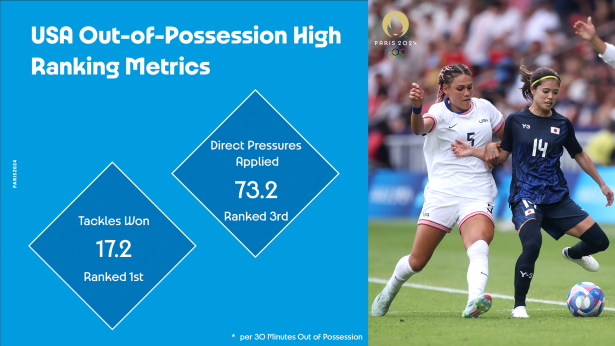
According to Anna Signeul, “The team’s defensive style is characterised by brave one-on-one defending, smart decision-making when considering when to press and when to drop, and they were very quick in the recovery. Players knew where to cover to establish defensive balance by anticipating their opponents’ intentions and defending on the front foot. They showed great awareness of when to apply a ball-winning press and when to recover into a block with centre-back, Naomi Girma (4), leading her defence with great physical strength, speed and football intelligence.”
In clip 7 below, we see an example of the USA’s intensity when applying direct pressure. When they go in, they go together, with players getting in close and tight to the player they are pressing until they suffocate their opponent’s attempts to progress their play.
In clip 8, we see an example of the powerful and committed recovery runs that the USA players made when their opponents were counter-attacking. In this example against Germany, we see how the seven recovering players focus their recovery runs in the central (most dangerous) channel. Once the ball is played wide, only the recovering defender who is nearest to the ball goes with the attacking player, while the other six focus on protecting the penalty area, with three on the edge of the goal area (front post, centre and back post area) with two more focusing on protecting the area around the penalty spot. Finally, the sixth player acts as ball-side cover. These recovery runs and positions allow them to cover any cross that may come into the penalty area and show their desire and pre-planned work to prioritise getting a 3+2 defensive structure in the penalty area as quickly as possible when they transition to defend.
Goalkeeper (Alyssa Naeher)
Already a centurion for her nation, goalkeeper Alyssa Naeher added a first Olympic gold medal to her extensive list of achievements in the game. The experience and bravery that she brought to her team’s defensive performances stood out for our Technical Study Group and here, Pascal Zuberbühler highlights some key interventions made by Naeher at crucial moments in big games.
There are many demands placed on the modern goalkeeper but, first and foremost, their role is also to prevent the opposition team from scoring goals. In the clips selected below, ‘Zubi’ explains why bravery and courage are key attributes for any goalkeeper who wants to play at the highest level.
Defend the space
“Goalkeepers have to be fearless and sometimes that means putting yourself in situations where you could get hurt but this is a crucial component of good goalkeeping. Dominating your goal area and understanding how to defend that space is vitally important when dealing with balls that come in low or high. In clip 9 below against Germany, we see how Naeher moves to her first post when the ball goes wide. She is not rooted to her post, but is a yard away, meaning she can protect more space in her goal area. When the ball is cut back towards a central runner, Naeher dives to her right and collects the ball at full stretch, protecting the space very well,” Zubi explained.
“In clip 10, we see all her experience and bravery in this situation against Japan. When the ball is played in towards her goal area, she makes a determined movement towards the ball despite the presence of incoming opposition attacking runs and her own defenders. She never takes her eyes off the ball and gets a strong hand to the ball to clear the immediate danger. In doing so, she takes contact from two players and ends up on the ground but immediately returns to her feet and gets set to deal with any further attacks.”
“Clip 11 comes from the 97th minute of their game against Australia. The USA were winning 2-1 and there were eight minutes of added time, so this was a time of high pressure in the game. In this situation, Australia have a corner and their goalkeeper was also in the penalty area to attack the ball. Seven of her own teammates are in the central part of the penalty area along with seven attacking players so the area is very congested. As the ball comes in, Naeher shows great determination, courage, experience and timing to power through the crowd and make a clean and vital punch to clear the ball from danger. This was a very impressive intervention at a very important time in the game,” Zubi added.
Crucial Saves
Making saves remains the most important skill for goalkeepers. Timing, positioning, courage are all important when the most crucial interventions are needed. Big saves from goalkeepers can have equal importance to goals being scored, especially in big moments of important games. Here, Zubi has selected three saves from Naeher that were vital for her team.
“In clip 12 below, in the 93rd minute of the final (with the USA winning 1-0) against Brazil, Naeher makes a crucial save from Adriana (9). As the cross is played, she adjusts from her central position and is in the set position ready for the attempt at goal. Her reactions and athleticism are excellent here as she gets a strong right hand to the ball before her defenders clear the danger. This was a big moment in the game and a crucial intervention.”
“In clip 13, we see a free kick from Germany where the first attempt at goal hits the USA’s wall and rebounds to the free kick taker, Klara Bühl (17). Naeher can see she has defensive cover at her near post which makes a low strike by the attacker to this area unlikely. The only options available are for Bühl to lift an attempt at goal over the advancing defenders or to cross to the back post area. Naeher anticipates this and advances towards the target area, making herself as big as possible to reduce the angles of attack. Her leap results in a crucial foot-block save with her left foot. Again, this is courageous goalkeeping,” Zuberbühler added.
“And finally, in clip 14, also against Germany, we see two important saves low to the ground. For the first one, she is set at her front post, but still leaves a yard of space to give her more reach for any cut-backs and, as the ball is passed, she adjusts quickly to save low with her legs. Immediately, she recovers to her feet and takes vital steps towards the ball as her defenders attempt to clear the danger.”
Summary
The USA secured their fifth Olympic gold medal in Paris, displaying some consistent team characteristics with a balanced team. In possession, while they played with a back four, they liked to build their play using just three, pushing their full-backs on and ensuring there was movement ahead of the ball. Once in the final third, their forwards were direct and pacy, looking to get attempts at goal early. On transition attack, they were also very effective at playing forward quickly, looking to break the opposition’s defensive line and get runners in behind.
When they did not have the ball, they were selective and aggressive when deciding when to apply direct pressure, especially in counter-press and defensive transition phases. Players recovered in numbers with intent and speed to protect the central channel of the penalty area, while they were also effective in 1v1 defending and tackling.
The USA’s players looked clear in their roles and understanding of their responsibilities, with players playing in positions that suited their key strengths.










